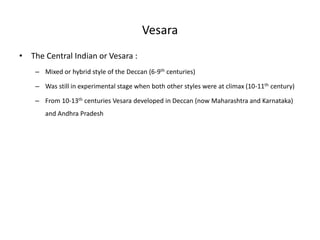HinduTempleVesara style from India.pptx
- 1. Vesara • The Central Indian or Vesara : – Mixed or hybrid style of the Deccan (6-9th centuries) – Was still in experimental stage when both other styles were at climax (10-11th century) – From 10-13th centuries Vesara developed in Deccan (now Maharashtra and Karnataka) and Andhra Pradesh
- 2. • Chalukyas • Ruled from Badami (Karnataka) around 543-753 • North and central Karnataka (Chalukyas) • South Karnataka (Hoysalas) • Hyderabad, Warangal (Kakatiya) • Egs. Pattadakal, Aihole, Badami • Rashtrakutas • Ruled from Gulbarga district (Karnataka) from 753-973 • Egs. Kailashnath temple, Ellora • Rock cut caves of Ellora and Elephanta • Western Chalukyas • Later or Kalyani Chalukyas (Karnataka)ruled from 973-1180 • Formed a conceptual link between Badami Chalukyas and Hoysalas of 13th century • Hoysalas • Ruled from Belur / Halebidu (Karnataka) from 1100-1343 • Egs. Keshava temple in Somnathpura, Chennakeshava temple in Belur Some important dynasties
- 3. Chalukyas Lad Khan temple, Aihole, late 7th century
- 5. Durga temple, Aihole, late 7th century Chalukyas
- 6. A = Shiva B = Narasimha C = Vishnu D = Varaha E = Durga F = Harihara
- 7. Rashtrakutas Kailashnath temple, Ellora, 8th century, Krishna I
- 14. Virupaksha temple, Hampi, Vijaynagara
- 15. Garuda shrine, Vitthala temple complex, Hampi
- 16. Western Chalukyas Itagi Mahadeva temple, 1112 C.E. Karnataka
- 17. Lathe turned pillars of Itagi Mahadeva temple
- 18. Hoysalas Keshava temple, Somnathpura, Karnataka, 1268 C.E., Narasimha III
- 22. Thank You






















